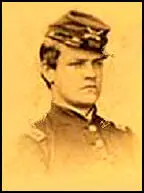Frank Wilkeson

Frank Wilkeson was born in Buffalo, New York State, on 8th March, 1848. He was the youngest son of the journalist, Samuel Wilkeson (1817-1889), and Catherine Cady, the sister of Elizabeth Cady Stanton.
Samuel Wilkeson covered the American Civil War for the New York Times. Meanwhile, the 14 year old Frank ran away from home and on 26th March, 1864 joined the Union Army. Claiming he was an eighteen year old farmer, Wilkeson enlisted in the 11th Battery of New York Light Artillery.
Wilkeson was sent to Northern Virginia where he took part in the military campaign led by General Ulysses S. Grant. This included Wilderness (May, 1864) and Petersburg (June, 1864). On 21st June, 1864, Wilkeson was commissioned as a 2nd Lieutenant in the 4th U.S. Artillery. He was sent to Washington and later he led a unit guarding prisoners in Elmira. Wilkeson left the army in March, 1866.
Wilkeson worked as a mining engineer in Pennsylvania and after marrying Mary Crouse in 1869, the couple settled in Johnstown. In 1871 they moved to Gypsum, Kansas, where they managed a large cattle ranch and wheat farm.
In the 1880s Wilkeson wrote for several newspapers including the New York Times. A book on his military experiences, Turned Inside Out: Recollections of a Private Soldier was published in 1887.
Frank Wilkeson died at Chelan, Washington, on 22nd April, 1913.
Primary Sources
(1) Frank Wilkeson wrote about the fighting in the Wilderness in his book, Turned Inside Out: Recollections of a Private Soldier (1887)
During the first day's fighting in the Wilderness, I saw a youth of about twenty years skip and yell, stung by a bullet through his thigh. He turned to limp to the rear. After he had gone a few steps he stopped, then he kicked out his leg once or twice to see if it would work. Then he tore the clothing away from his leg so as to see the wound. He looked at it attentively for an instant, and kicked out his leg again, then turned and took his place in the ranks and resumed firing.
There was considerable disorder in the line, and the soldiers moved to and fro - now a few feet to the right, now a few feet to the left. One of these movements brought me directly behind this wounded soldier. I could see plainly from that position, and I pushed into the gaping line and began firing. In a minute or two the wounded soldier dropped his rifle and, clasping his left arm, exclaimed: "I am hit again!" He sat down behind the battle ranks and tore off the sleeve of his shirt. The wound was very slight - not much more than skin-deep.
He tied his handkerchief around it, picked up his rifle, and took position alongside of me. I said: "You are fighting in bad luck today. You had better get away from here." He turned his head to answer me. His head jerked, he staggered, then fell, then regained his feet. A tiny fountain of blood and teeth and bone and bits of tongue burst out of his mouth. He had been shot through the jaws; the lower one was broken and hung down. I looked directly into his open mouth, which was ragged and bloody and tongueless. He cast cast his rifle furiously on the ground and staggered off.
(2) Frank Wilkeson, Turned Inside Out: Recollections of a Private Soldier (1887)
Wounded soldiers almost always tore their clothing away from their wounds so as to see them and to judge of their character. Many of them would smile and their faces would brighten as they realized that they were not hard hit and they would go home for a few months. Others would give a quick glance at their wounds and then shrink back as from a blow, and turn pale as they realized the truth that they were mortally wounded. The enlisted men were exceedingly accurate judges of the probable result which would ensue from any wound they saw. They had seen hundreds of soldiers wounded, and they had noticed that certain wounds always resulted in death. After the shock of discovery had passed, they generally braced themselves and died in a manly manner.
(3) Frank Wilkeson, Turned Inside Out: Recollections of a Private Soldier (1887)
Near Spotsylvania I saw, as my battery was moving into action, a group of wounded men lying in the shade cast by some large oak trees. All of these men's faces were gray. They silently looked at us as we marched past them. One wounded man, a blond giant of about forty years, was smoking a short briarwood pipe. He had a firm grip on the pipestem. I asked him what he was doing. "Having my last smoke, young fellow," he replied. His dauntless blue eyes met mine, and he bravely tried to smile. I saw he was dying fast. Another of these wounded men was trying to read a letter. He was too weak to hold it, or maybe his sight was clouded. He thrust it unread into the breast pocket of his blouse and lay back with a moan.
This group of wounded men numbered fifteen or twenty. At the time, I thought that all of them were fatally wounded and that there was no use in the surgeons wasting time on them, when men who could be saved were clamoring for their skillful attention. None of these soldiers cried aloud, none called on wife, or mother, or father. They lay on the ground, palefaced, and with set jaws, waiting for their end. When my battery returned from the front, five or six hours afterward, almost all of these men were dead.
Long before the campaign was over I concluded that dying soldiers seldom called on those who were dearest to them, seldom conjured their Northern or Southern homes, until they became delirious. Then, when their minds wandered and fluttered at the approach of freedom, they babbled of their homes. Some were boys again and were fishing in Northern trout streams. Some were generals leading their men to victory. Some were with their wives and children. Some wandered over the family's homestead; but all, with rare exceptions, were delirious.
(4) Frank Wilkeson, New York Times (28th July 1884)
Murrayville has one main street, from which, at intervals, are offshoots in the shape of side streets. It is about 75 feet wide, and is full of the stumps of the trees cut to make room for the town site. On either side of this main street, for perhaps an eighth of a mile, are ranged the stores. They are of every conceivable kind and shape. There are a few log houses, more tents and tent houses, but one-story frame buildings abound. A tent house is half log or frame house and half tent; it is simply a shell of logs or boards with a canvas roof. This kind of building is very plentiful in the West, and particularly popular in new towns. The canvas is not made specially for the houses; it is an ordinary tent adapted to the purpose. Their size is often considerable. I have seen them 90 by 30 feet, but the average are from 60 by 20 to 40 by 20. They are plentiful because they are cheap, lumber being an expensive article in a new country, but they are more comfortable than a tent. Anything covered with canvas is damp in rainy weather, and insufferably hot when the sun pours down upon it; besides light canvas is not waterproof, and here eight-ounce or bucking is used almost exclusively.
There is no seasoned lumber in the town, and promises not to be for some time owing to the limited capacity of the sawmills of the gulch. Everything has been built of green material, and for a long time lumber was worked into houses the same day it was sawed. It sells now for $35 per 1000 feet, and before any sawmills were put in it was at one time as high as $300 per 1,000 feet. At that time every plank was whip sawed, the amount made was small, and the demand was very great. Many thousands of feet were sold at $300, $275, $250 per 1,000 feet, and most of it was sold before it was cut. The sawmills, of course, hurt the tremendous profit of the business, but for a long time both they and the whip sawyers coined money. They have held prices up most persistently, but $35 per 1,000 feet is a high figure, and ought to satisfy them. The whip sawyers have not given up; they are still working and making sales.
For the benefit of those who know little of lumber I will say that whip-sawing is done by two men. The log is placed on two uprights. One man stands above on the log; the other is below. They have a long thin saw, with handles on either end. One man is continually pushing the saw, while the other is pulling it. The man below usually wears goggles to keep the sawdust from his eyes; whip sawing is hard work and slow work, but it pays, because running expenses are almost nothing. The freshness of the timber is seen most plainly in the frame houses. From those recently erected the pitch can be seen oozing in quantities. Besides this habit of oozing, the pitch has an extremely rude and unmannerly way of dropping constantly. When the inhabitants are not kept busy dodging the glistening balls, they have lively times making a general clean-up.


